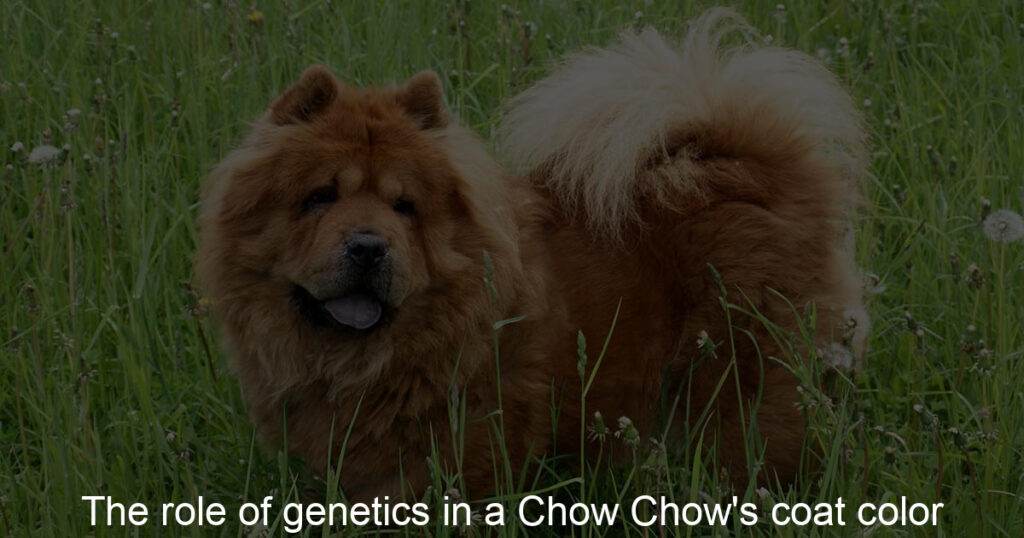Are you wondering why your Chow Chows’ coats come in such a wide variety of shades? While many environmental factors can play into the coat color of your pup, their genetics also have an enormous effect. Whether you’re looking for a loyal companion or just enjoy admiring these beautiful dogs, it’s important to understand how their genes shape the appearance – and likely even the personality – of your pet.
Let’s take a look at the role genetics plays when it comes to your Chow Chows’ coats!
What is the common color of Chow Chow?
The Chow Chow is a majestic dog breed with a distinct, fluffy lion-like appearance. They have thick fur and a fluffy ruff across their neck and chest. Many people recognize this breed through its common color: a stunning deep red-brown known as “red” Chow Chow. This distinctive reddish-brown color can be seen in its long hair that curls or stands out at the ends, giving it an even more unique appearance.
While it is common for the breed to be in this particular deep red-brown color, other colors like black, blue, cinnamon, and cream are also possible; however, they are much less seen. Each of these coat variations offers its beauty while staying very faithful to the original Chow Chow look.
What are the rarest Chow Chow colors?
The Chow Chow is a thick-coated dog whose colors depend on the different variations of the breed. While fawn and red are the classic colors, there are some rare colors available like black, blue, cinnamon, and cream. Black Chows are even more unusual than the others, as they are generally only found in special breeding lines with limited supplies each year.
The blue Chow is genetically a diluted black coat, while cream and cinnamon variants come from crossed breeds to get these unique colors. All of these colors have a special charm that makes them stand out from other breeds!
How does dog Colour DNA work?
Going to the dog store and seeing the wide variety of breeds you can choose from is fascinating. But have you ever stopped to wonder just how they all look so different? The answer lies in their color DNA! Each breed has specific traits that correspond with its breed as it is determined by its genetic makeup.
Dog color DNA determines what pigment should appear where determining specifics like eye and nose color. For example, a black Lab could carry the same pigment-causing gene as a golden retriever, but its black dominant gene is the one that shows on the surface.
It’s amazing how intricate genetics are when it comes to such differences and similarities between breeds, and understanding how dog color DNA works only adds to our appreciation for pup personalities!
What are the genetics of dog coats?
Understanding the genetics of dog coats can be a bit tricky! There are a lot of complex factors that go into determining things like color, pattern, length, and texture. Each factor is linked to specific genes and each dog carries two copies of each gene – one from each parent.
Most coat colors are determined by a dominant or recessive gene with some of the more common colors such as red, brown, and black being caused by dominant genes while chrome colors such as blue and cream can result from recessive genes.
Dog coat patterns are caused by both dominant and recessive genes but this area is still being studied so it’s hard to say exactly how these coat designs come about. Some breeds will have longer coats due to their double-layer coat genetics, while others may inherit a short layer of fur or hair as a result of different genetic combinations. Our four-legged friends received quite the gifted when it comes to their unique coats!
What determines a dog’s fur color?
Dog genetics is fascinating, especially when it comes to fur color! The base coloration of a dog’s fur is determined by its genetic code. Beyond that, other factors also contribute to the appearance of the coat. For example, the type of pigments present in the hair shafts influences how light or dark their fur will be; a genome with pigments that are more yellow-based will usually be lighter, whereas one with lots of pigments with black-based tones will be darker.
Furthermore, overlapping coats and white spotting can also overwhelm the genetic coloring pattern and significantly change the fur color! All in all, many elements come together to determine a pup’s unique look – making each one as special and unique as they are!
Conclusion
Ultimately, while there is much confusion surrounding the genetics of a Chow Chow’s coat color, genetic evidence indicates that the Chow will have combinations of chocolate, black, and red in its fur. Breeders have also developed genetically diverse markings for these colors to create a vibrant and unique look for the breed. With such diversity, it’s not surprising that the Chow is considered one of the most sought-after breeds in the world.
In addition to their stunning looks, it’s no surprise why this ancient breed has withstood the test of time, captivating people for centuries all over the world. With proper care and attention to their diet and exercise needs, many Chow Chows can live happily for up to 15 years or more – so if you ever get a chance to meet one in person then take it! There is little doubt that it will remain your furry companion for many loyal years ahead.














